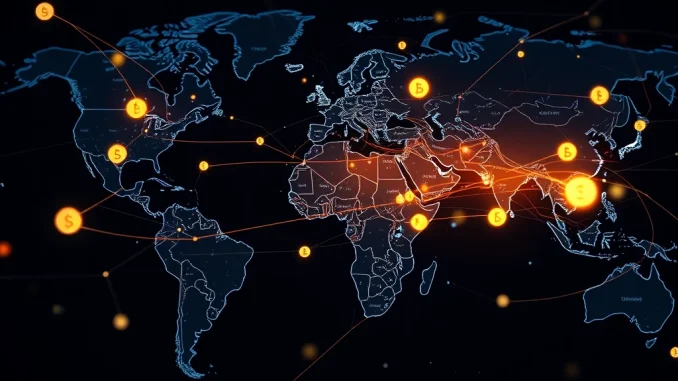
The world of global finance is constantly evolving, and one of the most persistent challenges has been the speed and cost of sending money across borders. Traditional systems can be slow, expensive, and complex. But what if there was a way to make cross-border transactions happen in real-time, powered by digital currency? This is where the Circle Payments Network comes into play.
What is the Circle Payments Network (CPN)?
Circle, a major player in the stablecoin space and the issuer of USDC, recently made a significant announcement via their official X account: the Circle Payments Network (CPN) has officially launched its mainnet. This isn’t just another crypto announcement; it represents a concrete step towards integrating stablecoins like USDC into mainstream financial flows, specifically for payments and settlements.
At its core, CPN is designed to facilitate real-time payments and settlements globally. It leverages the power of public blockchains to enable instant value transfer, a stark contrast to the multi-day settlement times often seen in traditional banking systems.
How Does CPN Enable Real-time Stablecoin Payments?
The magic behind CPN lies in its use of USDC, a widely adopted dollar-pegged stablecoin. By operating on public blockchains, CPN allows businesses and individuals to send and receive USDC directly, bypassing traditional intermediaries and their associated delays and fees. This means a payment initiated in one country can arrive and settle almost instantly in another, ready to be used or converted.
This approach fundamentally changes the paradigm for stablecoin payments. Instead of stablecoins being primarily trading assets or on-ramps to decentralized finance, CPN positions them as a core technology for everyday (or at least business-to-business and enterprise) financial operations.
Who is Already Using CPN and Where?
The mainnet launch isn’t just a technical release; it comes with real-world participants already integrated. Circle highlighted several early adopters:
- Alfred
- Tazapay
- Conduit
- RedotPay
These initial participants are crucial as they demonstrate the network’s practical application. Their involvement is already expanding the use of stablecoin payments across key growth regions, specifically Latin America and Asia. This geographical focus suggests CPN is targeting markets where traditional payment infrastructure can be more challenging or costly, making the benefits of instant, low-cost settlements particularly appealing.
Why Are Real-time, Cross-border Payments Important?
The ability to conduct real-time payments across borders has profound implications for various sectors:
Business-to-Business (B2B) Payments:
Companies often face delays when paying international suppliers or receiving payments from overseas clients. CPN can dramatically speed this up, improving cash flow and reducing the need for costly financing or hedging against currency fluctuations during transit.
Cross-border Remittances:
Sending money home is a lifeline for many families. Traditional remittance services can charge high fees and take time. CPN offers a path towards faster, cheaper remittances, ensuring more money reaches those who need it most.
Enterprise Payments:
Large enterprises with complex global operations require efficient ways to move funds between subsidiaries, pay international staff, or manage global treasury. CPN provides a programmable, instant layer for these critical financial operations.
The core benefit across these use cases is the shift from batch processing and delayed settlements to immediate, final settlement. This reduces counterparty risk and unlocks capital that would otherwise be tied up in transit.
CPN vs. Traditional Payment Systems: A Quick Look
Let’s briefly compare CPN’s approach to conventional methods for cross-border payments:
| Feature | Traditional Systems (e.g., SWIFT) | Circle Payments Network (CPN) |
|---|---|---|
| Speed | Hours to Days | Real-time (Seconds to Minutes) |
| Cost | Variable, often high fees (especially for smaller amounts) | Potentially lower transaction costs |
| Transparency | Often opaque tracking | On-chain visibility (depending on blockchain) |
| Accessibility | Requires banking relationships | Accessible to businesses and platforms integrated with CPN |
| Settlement Asset | Fiat currency (requiring FX conversion steps) | USDC (a stable digital dollar) |
This comparison highlights CPN’s potential advantages, particularly for speed and cost-efficiency in facilitating cross-border payments using USDC.
Challenges and the Road Ahead
While the launch of the Circle Payments Network mainnet is a significant milestone, challenges remain. Regulatory clarity around stablecoins and their use in payments varies globally. Adoption requires businesses to integrate with the network, which takes time and technical effort. Educating potential users about the benefits and mechanics of stablecoin payments is also crucial.
However, the trend towards digital currencies and faster payments is undeniable. CPN’s launch positions Circle to capture a piece of the massive global payments market by offering a compelling alternative powered by blockchain technology and USDC.
Conclusion: A Step Towards Instant Global Commerce
The official mainnet launch of the Circle Payments Network marks an exciting development in the world of finance and blockchain. By enabling real-time payments and settlements using USDC on public blockchains, CPN offers a glimpse into a future of instant, efficient, and potentially lower-cost cross-border payments. With initial participants already leveraging the network in key regions, Circle is paving the way for wider adoption of stablecoin payments in B2B, remittance, and enterprise contexts. This is a vital step towards making global commerce faster and more accessible for everyone.



